#skill section html css
Photo
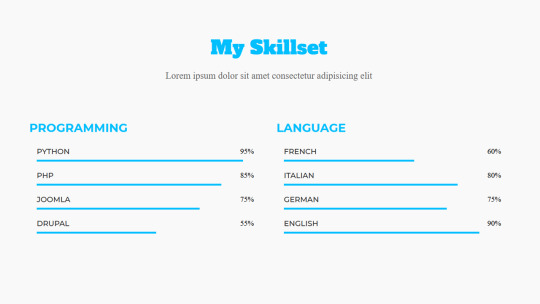
Responsive Skills Section Design
#skill section html css#responsive skill section#skill section page#html css#html5#css3#webdesign#frontenddevelopment#frontend#code#learn css#learn to code#codenewbies#responsive web design
3 notes
·
View notes
Text
beginner’s guide to the indie web
“i miss the old internet” “we’ll never have websites like the ones from the 90s and early 2000s ever again” “i’m tired of social media but there’s nowhere to go”
HOLD ON!
personal websites and indie web development still very much exist! it may be out of the way to access and may not be the default internet experience anymore, but if you want to look and read through someone’s personally crafted site, or even make your own, you can still do it! here’s how:
use NEOCITIES! neocities has a built in search and browse tools to let you discover websites, and most importantly, lets you build your own website from scratch for free! (there are other ways to host websites for free, but neocities is a really good hub for beginners!)
need help getting started with coding your website? sadgrl online has a section on her website dedicated to providing resources for newbie webmasters!
HTML (HyperText Markup Language) and CSS (Cascading Style Sheets) are the core of what all websites are built on. many websites also use JS (JavaScript) to add interactive elements to their pages. w3schools is a useful directory of quick reference for pretty much every HTML/CSS/JS topic you can think of.
there is also this well written and lengthy guide on dragonfly cave that will put you step by step through the basics of HTML/CSS (what webpages are made from), if that’s your sort of thing!
stack overflow is every programmer’s hub for asking questions and getting help, so if you’re struggling with getting something to look how you want or can’t fix a bug, you may be able to get your answer here! you can even ask if no one’s asked the same question before.
websites like codepen and jsfiddle let you test HTML/CSS/JS in your browser as you tinker with small edits and bugfixing.
want to find indie websites outside the scope of neocities? use the search engine marginalia to find results you actually want that google won’t show you!
you can also use directory sites like yesterweb’s link section to find websites in all sorts of places.
if you are going to browse the indie web or make your own website, i also have some more personal tips as a webmaster myself (i am not an expert and i am just a small hobbyist, so take me with a grain of salt!)
if you are making your own site:
get expressive! truly make whatever you want! customize your corner of the internet to your heart’s content! you have left the constrains of social media where every page looks the same. you have no character limit, image limit, or design limit. want to make an entire page or even a whole website dedicated to your one niche interest that no one seems to be into but you? go for it! want to keep a public journal where you can express your thoughts without worry? do it! want to keep an art gallery that looks exactly how you want? heck yeah! you are free now! you will enjoy the indie web so much more if you actually use it for the things you can’t do on websites like twitter, instead of just using it as a carrd bio alternative or a place to dump nostalgic geocities gifs.
don’t overwhelm yourself! if you’ve never worked with HTML/CSS or JS before, it may look really intimidating. start slow, use some guides, and don’t bite off more than you can chew. even if your site doesn’t look how you want quite yet, be proud of your work! you’re learning a skill that most people don’t have or care to have, and that’s pretty cool.
keep a personal copy of your website downloaded to your computer and don’t just edit it on neocities (or your host of choice) and call it a day. if for some reason your host were to ever go down, you would lose all your hard work! and besides, by editing locally and offline, you can use editors like vscode (very robust) or notepad++ (on the simpler side), which have more features and is more intuitive than editing a site in-browser.
you can use ctrl+shift+i on most browsers to inspect the HTML/CSS and other components of the website you’re currently viewing. it’ll even notify you of errors! this is useful for bugfixing your own site if you have a problem, as well as looking at the code of sites you like and learning from it. don’t use this to steal other people’s code! it would be like art theft to just copy/paste an entire website layout. learn, don’t steal.
don’t hotlink images from other sites, unless the resource you’re taking from says it’s okay! it’s common courtesy to download images and host them on your own site instead of linking to someone else’s site to display them. by hotlinking, every time someone views your site, you’re taking up someone else’s bandwidth.
if you want to make your website easily editable in the future (or even for it to have multiple themes), you will find it useful to not use inline CSS (putting CSS in your HTML document, which holds your website’s content) and instead put it in a separate CSS file. this way, you can also use the same theme for multiple pages on your site by simply linking the CSS file to it. if this sounds overwhelming or foreign to you, don’t sweat it, but if you are interested in the difference between inline CSS and using separate stylesheets, w3schools has a useful, quick guide on the subject.
visit other people’s sites sometimes! you may gain new ideas or find links to more cool websites or resources just by browsing.
if you are browsing sites:
if the page you’re viewing has a guestbook or cbox and you enjoyed looking at the site, leave a comment! there is nothing better as a webmaster than for someone to take the time to even just say “love your site” in their guestbook.
that being said, if there’s something on a website you don’t like, simply move on to something else and don’t leave hate comments. this should be self explanatory, but it is really not the norm to start discourse in indie web spaces, and you will likely not even be responded to. it’s not worth it when you could be spending your time on stuff you love somewhere else.
take your time! indie web doesn’t prioritize fast content consumption the way social media does. you’ll get a lot more out of indie websites if you really read what’s in front of you, or take a little while to notice the details in someone’s art gallery instead of just moving on to the next thing. the person who put labor into presenting this information to you would also love to know that someone is truly looking and listening.
explore! by clicking links on a website, it’s easy to go down rabbitholes of more and more websites that you can get lost in for hours.
seeking out fansites or pages for the stuff you love is great and fulfilling, but reading someone’s site about a topic you’ve never even heard of before can be fun, too. i encourage you to branch out and really look for all the indie web has to offer.
i hope this post helps you get started with using and browsing the indie web! feel free to shoot me an ask if you have any questions or want any advice. <3
#webcore#old web#nostalgia#geocities#neocities#internet nostalgia#indie web#90s#early 2000s#y2k#guide#masterpost#html#css#javascript#internetcore#hope all these tags are appropriate for outreach!#wasn't quite sure#ayano was here#long post#i didn't want to advertise in this guide but if you're reading this my website is classicpokemonguide by the way!
24K notes
·
View notes
Text
reaching out to any Jews willing to talk to me (i am pro-israel)
now that my pinned post is getting too long and disorganized, I feel the need to make a better resource for all of this information. originally, i was going to just redo the map section with an update on new ones that i found. making a separate post just for that and linking solely to that. but instead i'm wondering if something more like a linktree or it's own website/blog would be useful?
i know HTML/CSS and though i haven't used my skills in a bit, i am willing to pick it back up for this.
however, i didn't want to do this without getting opinions from Jews & Jumblr itself. i also wanted to ask if there were more resources that could be shared with me and if we could collab on this project?
As a non-Jew reading all of this hate is hard enough but I'm willing to bet it is twice as hard as a Jew, so I'm willing to take the brunt of it while anyone willing to speak to me or whatever stays anonymous.
please spread this post as I'm genuinely trying to help. my DM's are open and I genuinely would like an answer. I'm not going to tag anyone in this despite there being very prominent openly Jewish blogs on this website as I don't want to send any hateful people towards you.
even if you don't reblog the post, liking it and sending a link to others would be appreciated.
I stand with Israel and with the Jews. I'm tired of not doing anything beyond meaningless fights on the internet.

55 notes
·
View notes
Text
How To: Gradient AO3 Divider

Last year we prepared a little something to make the fics written for our event more uniform and look a little more fun. This materialized as a workskin coded by @alto-tenure that contains a colourful gradient divider for AO3 from the colours of our theme.
To learn how to make yourself a colourful divider like this one without any graphic skills, see the tutorial under the read-more.

At first, you'll need to create a Work Skin:
Go to your profile on AO3 and choose the “Skins” option. Click “My Work Skins”, and there “Create Work Skin”.
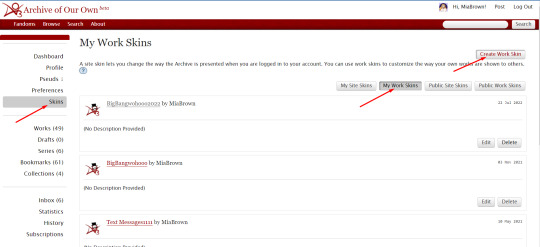
Name the skin. (This has to be a unique name out of every AO3 user’s personal workskins, so “BigBang” or other straightforward names will most likely be taken, meaning you have to play around a little to find an eligible one.)
To the “CSS” box, copy paste the following html code and insert the HEX code of the colours you want to use (for example, #66c50b for our brightest green). We specified out 6 colours here, but you can use as many as you like.
#workskin .hr {
height: 3px;
width: 35%;
background-image: linear-gradient(to right, #HEXcode, #HEXcode, #HEXcode);
text-align: center;
}

Click “Update” at the bottom of the page.
2. Second, you'll need to start using the Work Skin
Go to publish a new work or chapter like you normally would.
At the “Associations” section, select the previously created Work Skin.

Insert the text like you normally would, then click on the “HTML”view. Here, search for the placeholder(s) you left, where the section break(s) have to be.
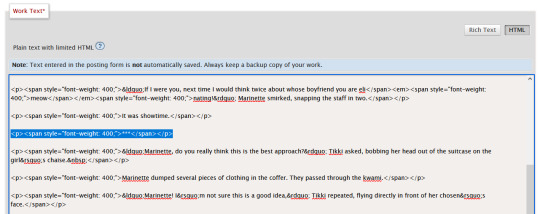
Delete these, replacing them with the following code at every place you want to have a divider:
<div align="center">
<div class="hr"></div></div>
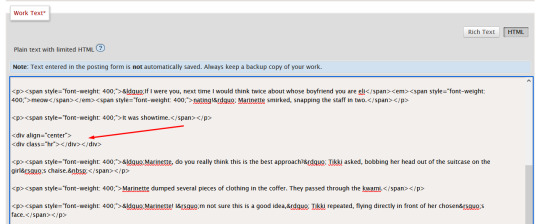
You're done, post your work! 🎉

65 notes
·
View notes
Note
Anon so this doesn't come from my main but it's nsfruitw- I LOVE YOUR BLOG CODING OMG??? THE WORKING BUTTONS AND MOVING WINDOWS ARE SO AWESOME???? I'm so excited for Dee's ask blog!!!
<OOC:>
Ahhhhhh!!! thank you!!!
I had three different potential blogs.. but a lot of them didn't really met my wishes/criteria.
Which in case you're interested were:
Windows 98 look
Search bar
Visible tags
One Column
Separate Window for your Profile Info with a picture.
(maybe separate icons or a lil menu for links)
No endless scrolling/seperate pages
I will put everything else under the cut since the post became quite long haha
This was one of the first themes I tried out (tbh I kinda jumped between all of them, trying stuff out)
I loveeee the start bar on this one, the icons and that it can be one or two columns. But it has no search bar and I didn't like that the profile section is super small, has no picture and couldn't be swapped to the left instead of the right side. I'm not confident enough in my html/css skills to competently yoink that start bar and transplant it into a different theme
Pros VS Cons:
+ animated start-bar (with accurate time in the corner)
+ one column (or two columns)
+ Windows 98 look + functional corner buttons
+ icons
+ custom background picture
- no search bar
- tiny info profile window, no picture (can't be moved to the left side)
- endless scrolling
- no visible tags

I prefer this theme for the most part over the previous one.. even if i loveee the functional startbar feature there!
Its practically perfect. it can be one or two columns (i prefer one column blog layouts personally)
You can add a lil picture in the profile section, its on the left side and you have a search bar!
I also looooveee that the post windows look extremely accurate and that the tags are always visible. (< another thing thats often kinda hidden in themes, so i tend to forget about it)
Also the lil corner buttons can actually be used to like or reblog the post! what a highlight<3.
my only issue was that i couldnt add a background picture.. and i kinda liked the idea of having separate icons for obvious links like I do now.
Pros VS Cons:
+ Windows 98 look + functional corner buttons
+ one column (or two columns
+ No endless scrolling (page by page)
+ Left side Info Window with picture and links
+ Visible tags
- no custom background picture

Another theme that I tried out is this one
They made the same theme I ended up using.
It has a built in music player (that wont auto run!) a profile section + picture, customizable icons and background. But the biggest thing for me is that it doesn't have a search bar and I really need/want searchbars in my themes.
It's a really solid theme! It just fell a lil short for what I wanted to have
Pros VS Cons:
+ Windows 98 look
+ one column
+ No endless scrolling (page by page)
+ Left side Info Window with picture and links
+ Visible tags
+ music player (bonus)
+ custom icons and custom background picture
+ custom lil link window
- no searchbar (my biggest issue with a lot of themes haha)

Okay so last is the theme I ended up using which is this one:
It's very similar to the previous theme (Nostalgia 98) and was made by the same person. I edited the code a lil to have the tags be visible instead of needing to hover and to add another icon for links. It works but it’s also the only icon that isn’t draggable haha
Pros VS Cons:
+ Windows 98 look
+ one column
+ No endless scrolling (page by page)
+ Left side Info Window with picture and links
+ custom icons and custom background picture
+ custom icons for custom links
- no visible tags (I edited the code a lil so they're permanently visible)
3 notes
·
View notes
Text
My 365 Days Streak at MIMO ...

"At Mimo, we believe that coding can open doors to opportunities like few other skills. That's why we've rallied around the purpose of making coding accessible to as many people as possible." MIMO

Today I completed my 365 day streak at Mimo. Phew, that was a long way through the programming and scripting languages “Python”, “SQL”, “HTML”, “CSS” and “JavaScript”.
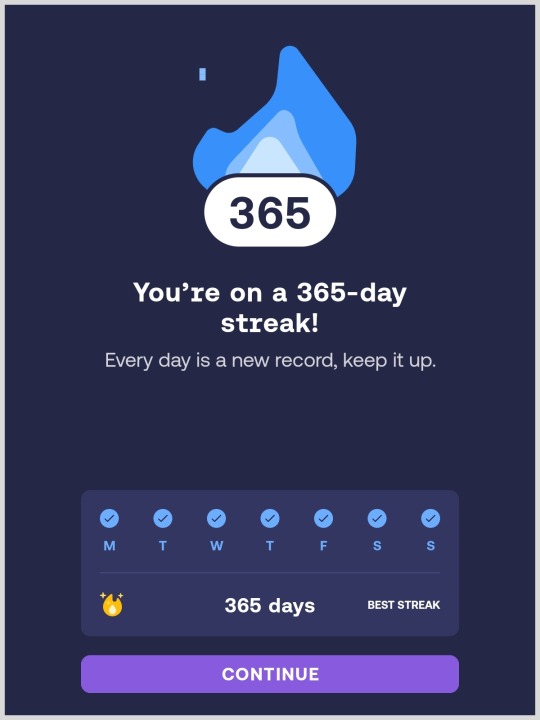
Even though there were sometimes tough times and I often repeated certain course sections, e.g. with "JavaScript", and the progress wasn't immediately apparent, I still enjoyed learning with MIMO again and again.

The support is also good, if you have questions or just get stuck. I can recommend MIMO to anyone who wants to immerse themselves in the world of programming languages online or with the app.
Post #209: Whoopee! My 365 Day streak on Mimo happens today on March 3, 2024.
#coding#programming#coding for kids#programmieren#education#javascript#css#sql#mimo#programming languages#html#teaching#learning#development#developer#developer community
6 notes
·
View notes
Text
The Ultimate Guide to Web Development
In today’s digital age, having a strong online presence is crucial for individuals and businesses alike. Whether you’re a seasoned developer or a newcomer to the world of coding, mastering the art of web development opens up a world of opportunities. In this comprehensive guide, we’ll delve into the intricate world of web development, exploring the fundamental concepts, tools, and techniques needed to thrive in this dynamic field. Join us on this journey as we unlock the secrets to creating stunning websites and robust web applications.
Understanding the Foundations
At the core of every successful website lies a solid foundation built upon key principles and technologies. The Ultimate Guide to Web Development begins with an exploration of HTML, CSS, and JavaScript — the building blocks of the web. HTML provides the structure, CSS adds style and aesthetics, while JavaScript injects interactivity and functionality. Together, these three languages form the backbone of web development, empowering developers to craft captivating user experiences.
Collaborating with a Software Development Company in USA
For businesses looking to build robust web applications or enhance their online presence, collaborating with a Software Development Company in USA can be invaluable. These companies offer expertise in a wide range of technologies and services, from custom software development to web design and digital marketing. By partnering with a reputable company, businesses can access the skills and resources needed to bring their vision to life and stay ahead of the competition in today’s digital landscape.
Exploring the Frontend
Once you’ve grasped the basics, it’s time to delve deeper into the frontend realm. From responsive design to user interface (UI) development, there’s no shortage of skills to master. CSS frameworks like Bootstrap and Tailwind CSS streamline the design process, allowing developers to create visually stunning layouts with ease. Meanwhile, JavaScript libraries such as React, Angular, and Vue.js empower developers to build dynamic and interactive frontend experiences.
Embracing Backend Technologies
While the frontend handles the visual aspect of a website, the backend powers its functionality behind the scenes. In this section of The Ultimate Guide to Web Development, we explore the world of server-side programming and database management. Popular backend languages like Python, Node.js, and Ruby on Rails enable developers to create robust server-side applications, while databases such as MySQL, MongoDB, and PostgreSQL store and retrieve data efficiently.
Mastering Full-Stack Development
With a solid understanding of both frontend and backend technologies, aspiring developers can embark on the journey of full-stack development as a Software Development company in USA. Combining the best of both worlds, full-stack developers possess the skills to build end-to-end web solutions from scratch. Whether it’s creating RESTful APIs, integrating third-party services, or optimizing performance, mastering full-stack development opens doors to endless possibilities in the digital landscape.
Optimizing for Performance and Accessibility
In today’s fast-paced world, users expect websites to load quickly and perform seamlessly across all devices. As such, optimizing performance and ensuring accessibility are paramount considerations for web developers. From minimizing file sizes and leveraging caching techniques to adhering to web accessibility standards such as WCAG (Web Content Accessibility Guidelines), every aspect of development plays a crucial role in delivering an exceptional user experience.
Staying Ahead with Emerging Technologies
The field of web development is constantly evolving, with new technologies and trends emerging at a rapid pace. In this ever-changing landscape, staying ahead of the curve is essential for success. Whether it’s adopting progressive web app (PWA) technologies, harnessing the power of machine learning and artificial intelligence, or embracing the latest frontend frameworks, keeping abreast of emerging technologies is key to maintaining a competitive edge.
Collaborating with a Software Development Company in USA
For businesses looking to elevate their online presence, partnering with a reputable software development company in USA can be a game-changer. With a wealth of experience and expertise, these companies offer tailored solutions to meet the unique needs of their clients. Whether it’s custom web development, e-commerce solutions, or enterprise-grade applications, collaborating with a trusted partner ensures seamless execution and unparalleled results.
Conclusion: Unlocking the Potential of Web Development
As we conclude our journey through The Ultimate Guide to Web Development, it’s clear that mastering the art of web development is more than just writing code — it’s about creating experiences that captivate and inspire. Whether you’re a novice coder or a seasoned veteran, the world of web development offers endless opportunities for growth and innovation. By understanding the fundamental principles, embracing emerging technologies, and collaborating with industry experts, you can unlock the full potential of web development and shape the digital landscape for years to come.
2 notes
·
View notes
Text
Where to Learn to Code for Free
App Academy Open
In signing up for App Academy Open, you’ll access more than 1,500 hours of completely-free curriculum that includes machine learning, data science, data structures, computer programming languages, and building frameworks for iOS and Android mobile apps — as well as how to apply these skills, step-by-step, in real-world applications. And if you’d like additional support, you’ll also have the option of utilizing the $29.99/month mentorship program for features such as an instructor-led chatroom with the opportunity to work alongside other App Academy Open students!
Visit App Academy Open
Codecademy
Codecademy is a popular platform for beginning a coding journey. You can start from square one, or you can evaluate your skills to find the level that suits you the best. And their instant-testing of coding skills (including HTML & CSS, JavaScript, PHP, Python, Ruby, Angularjs, The Command Line, and more) allows you to learn and practice in real-time to make sure you’re understanding concepts correctly.
Visit Codecademy
freeCodeCamp
freeCodeCamp.org is a nonprofit that offers around 3,000 hours of coding curriculum, but they also go beyond that. Once you’ve finished learning to code, they’ll give you the opportunity to work on projects for other nonprofits. This way, you’ll get hands-on, real-world experience while earning your free certification.
Visit freeCodeCamp
Khan Academy
Like freeCodeCamp, Khan Academy is also a nonprofit — however, rather than focusing on tech, they instead offer a wide range of programs. While their selection of coding classes may not be as robust as other platforms, they are a great place for beginners and even provide courses for young children, to begin building their skills early!
Visit Khan Academy
Coursera
Coursera also opts not only to offer courses in which to learn to code, but also a range of programs provided through other colleges, universities, and companies. Although, while there are several free courses available in addition to paid, any certifications would only be accessible through their paid options.
Visit Coursera
Udemy
Similar to Coursera and Khan Academy, Udemy offers courses covering a variety of topics, which includes a section on coding. And although most of their courses are paid (costing roughly $20–$200 each), they do have some free options available as well — although you’ll only be able to view the video content. Any certifications or instructor interactions are only included in their paid programs. Additionally, you’ll want to make sure to check star ratings, reviews, and instructor credentials, since anyone can add a class to Udemy’s site!
Visit Udemy
18 notes
·
View notes
Text

Independent Archive Survey
What skills do you already have in web design, web development, or site-building?
Competence Exists (>50% of respondents have this skill)
HTML
CSS
Wordpress
Competence Developing (25-49% of respondents have this skill)
Python
Other coding language
MySQL
Graphics design
Area of Need (<25% of respondents have this skill)
Drupal
Other content management system
PHP
Analysis
I debated about how best to visualize these data, which are perhaps the most complex in the survey. Being an educator and therefore used to thinking in terms of proficiency, I decided to represent the data in that way: which technical skills are most needed among potential archivists.
And, to be clear, everything on this survey is not required to run an archive. I am emphatically not a coder but have run a successful archive for many years now using first eFiction and now Drupal. I had two purposes in asking this question. First: if I make tutorial materials, where is my effort best spent? You don't have to know HTML and CSS to use Drupal, but it sure makes things (especially theming!) easier if you have at least some understanding of them. Second: where are efforts to expand options for building independent archives best directed?
On the second question, Wordpress surfaces and not for the first time. There have been various efforts and making a fanfic archive plugin for Wordpress over the years. My SWG co-admin Russandol and I even tinkered with Wordpress last year, trying to build an archive using existing plugins. From what we can find of supported plugins, it doesn't seem possible at this time.
But the data here suggest that it would be ideal if it were possible. Many fans have at least some experience with Wordpress, and some have quite a bit. The ability to provide an archive option that builds on existing competence is ideal.
I do think it's likely that respondents were underestimating their skills. I do not think that only one respondent had an expert knowledge of HTML. Unfortunately, it is difficult to define what is meant by beginner, intermediate, and expert without getting bogged down, and we fandom people are very good at imposter syndrome. ("I can't possibly be an expert in this useful thing!") I'd define "expert" as "able to do what is needed using this tool or knowing how to find information to do what is needed," and I'm guessing more than a few of the "intermediates" can in fact do this for HTML, which makes me think that all of the graphs may see an upward shift in terms of expertise levels.
What is the independent archive survey?
The independent archive survey ran from 23 June through 7 July 2023. Eighty-two respondents took the survey during that time. The survey asked about interest in independent archives and included a section for participants interested in building or volunteering for an independent archive. The survey was open to all creators and readers/viewers of fanworks.
What is an independent archive?
The survey defined an independent archive as "a website where creators can share their fanworks. What makes it 'independent' is that it is run by fans but unaffiliated with any for-profit or nonprofit corporations or organizations. Historically, independent archives have grown out of fan communities that create fanworks."
Follow the tag #independent archives for more survey results and ongoing work to restore independent archives to fandoms that want them.
Independent Archives Survey Masterpost
#independent archives#fandom studies#fanfiction archives#fandom data#independent archive survey#sorry this one is so late#these data were much trickier to work with than previous sets
6 notes
·
View notes
Text
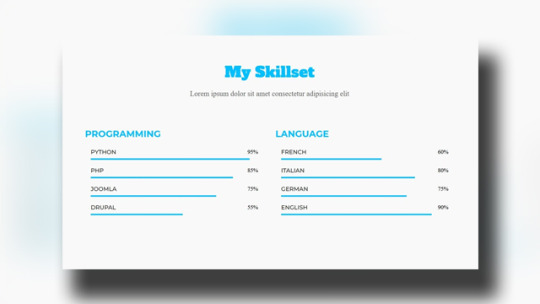
Responsive MY Skills Section
#responsive skill section#codenewbies#html css#frontenddevelopment#css#html5 css3#webdesign#css tricks#skill bar css
1 note
·
View note
Text
Brower Electric - Commit #0: Figma
Hello internet. I've been taking a web development class and we are now working on our final project for the semester. We are making a website for an electrical contracting company named Brower Electric. If the owners of the company like our website best, they will use it live. It's an opportunity to show our skills and get a great starting project for our resumes.
Brower Electric is a longstanding family-owned general electrical contracting business that specializes in commercial electrical jobs, but has experience in industrial and residential too.
They wanted a simple, attractive, professional page that kept consistent coloring. They wanted contact information, project information, resume submission, and testimonials front-and-center.
I used Figma to do my design work. It's a simple, browser-based online design tool that uses frames and layers.
I would have produced multiple wireframes/mockups to move together towards a design if I had more interview opportunities with the client.
I designed/wireframed for the desktop, but I will use Bootstrap 5 when I write the HTML and CSS which is built mobile-up. This may be an oversight but I learn best by experiencing the consequences of my actions.
Home Page - Front Facade:

The first thing when you see the page will be a carousel that switches through cards that display testimonials. By using a grey background on the cards, I help keep color variety to a minimum. Because neutral colors don't count.
I kept a simple solid background that matches the logo. Simple and consistent, per the client's request.
The navbar has a Call Now button in bold red to funnel users towards contact with the client. The navbar will be sticky so it is always visible. I used a lighter blue for the background, just dragging the color picker from the body/logo color until it was something attractive
The logo was hand-drawn. I used a web tool to remove the background and nested the company name in it.
There is also another contact button specifically for quotes. This will also funnel users to contact. It will not collapse on mobile so it will be a useful way to contact the company with only a small scroll. No toggling required.
Home Page:
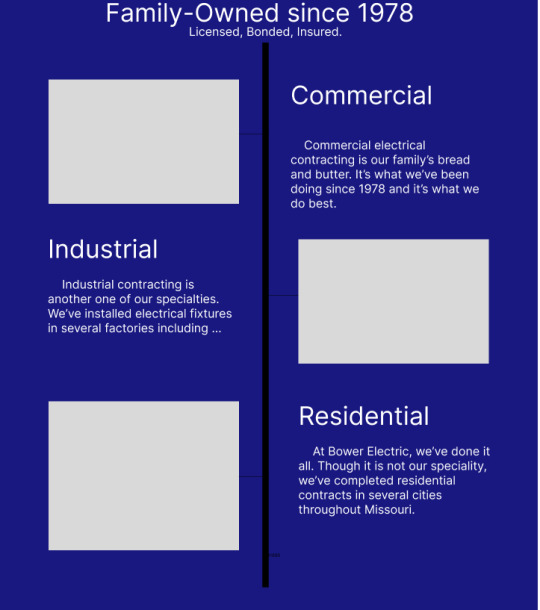
The next section of the homepage goes over the types of services offered. The blank spaces will be stock images related to the heading on the other side of the tree. On mobile, the text will overlay on the image, they will stack in one column, and there will be no tree.
I made a point to include that they were family-owned, established, as well as Licensed Bonded and Insured. This builds customer confidence in the business.
I will likely use a Bootstrap Grid to build this section.

I will also use cards to display the current projects. They will stack on mobile. The current projects gives an idea of the contractors workload as well as what the staff is freshly-trained to do.
The simple footer on the bottom provides contact info and a nav on the bottom for user-friendliness.
About Us:

The about us page is simple and straightforward, because that's how these folks run their business. A past projects accordion will be a space-efficient way to include all their projects (there are a lot, these guys have been in the biz for decades.)
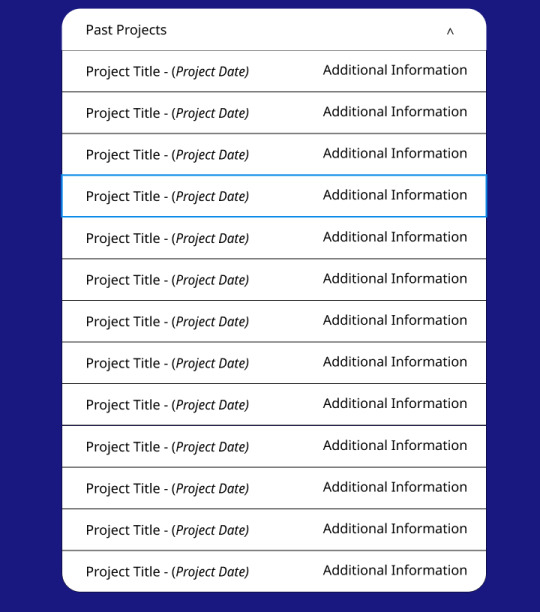
Contact Us:

I decided to display the contact information on cards in the contact us page. The large central card serves as a general directory on what number to call to get things done quickly. I left the former owner on the site, but excluded his contact information. People looking for Mike Brower's company now know that it is still in business, this is it's website, and that Mike is retired.
Donald doesn't like to be contacted directly. So I put a message on his card to funnel contact through someone else first.
Careers:

This page is a simple form submission for a resume. It is very bare bones because the client requested something simple that just lets him do a quick initial screen and initiate contact himself.
They are always hiring for different positions so the user must specify what kind of job title they are looking for.
Conclusion:
Designing this site was fun! I don't really consider myself a creative so building something like this was a great confidence booster. I feel very confident in my ability to code this website for 2 reasons: first, I have built very similar things before, such as the glamourscreens website I built earlier this semester; second, most everything I have included in this website has extensive support included in Bootstrap 5.
This feels like some of my best work yet, and I feel confident that it is something the client will be very pleased with too.
3 notes
·
View notes
Text
Build a FAQ Accordion Website
IntroductionHello, developers! I’m excited to share my latest project: a FAQ Accordion web application. This project is perfect for those looking to create an interactive and user-friendly FAQ section for their websites. It’s a great way to enhance your frontend development skills using HTML, CSS, and JavaScript while building a practical component that can be […]
The post Build a FAQ Accordion Website appeared first on TECH - WEB DEVELOPMENT NEWS. https://tech-webdevelopment.news-6.com/build-a-faq-accordion-website/
0 notes
Text
What to Expect from a Comprehensive Full Stack Web Development Course?
Embarking on a comprehensive full stack web development course offers an exciting journey into the world of web creation and technology. Such a course typically covers both front-end and back-end development, providing a robust foundation in essential programming languages and tools. You can expect to gain proficiency in HTML, CSS, JavaScript, full stack web development courseand frameworks like React or Angular, as well as server-side technologies such as Node.js, databases, and APIs. The course will also address best practices in design, development, and deployment, equipping you with the skills needed to build and manage complete web applications. Whether you’re aiming to start a new career or enhance your existing skills, a full stack web development promises a comprehensive, hands-on learning experience.
Foundational Skills in Front-End Development Full Stack Web Development Course
A comprehensive full stack web development course typically begins with a focus on front-end development, teaching essential skills for creating visually appealing and interactive user interfaces. Expect to learn HTML, CSS, and JavaScript—cornerstones of web development. You'll explore frameworks and libraries such as React or Angular to enhance your ability to build responsive, dynamic web pages. By the end of this section, you should be able to design and implement user-friendly interfaces that cater to various devices and screen sizes, setting a strong foundation for more advanced topics.
Mastery of Back-End Technologies Full Stack Web Development Course
In the back-end section of a full stack web development course,you'll dive into server-side development, where you'll learn how to create and manage databases, server-side logic, and APIs. Expect to gain proficiency in languages like Node.js, Python, or Ruby, and explore frameworks such as Express or Django. This part of the course will cover database management with SQL or NoSQL systems, handling authentication, and developing RESTful APIs. Mastery of these skills will enable you to build robust, scalable server-side applications that power the functionality of modern websites.
Integration of Front-End and Back-End Full Stack Web Development Course
A significant aspect of full stack web development course is understanding how to seamlessly integrate front-end and back-end technologies. You'll learn to connect your user interfaces with server-side functionality, ensuring that data flows smoothly between the client and server. Expect to work with tools and methodologies like AJAX or Fetch API to manage asynchronous operations and enhance user experiences. You'll also explore how to handle state management and session control, ensuring that both the user interface and server-side logic work harmoniously to deliver a cohesive application.
Database Design and Management Full Stack Web Development Course
Database design and management are crucial components of full stack web development. In a comprehensive course, you'll learn how to design relational databases with SQL, as well as manage NoSQL databases for more flexible data storage solutions. Expect to cover schema design, query optimization, and data migration. Additionally, you'll explore best practices for data security and integrity, ensuring that your applications can efficiently handle large volumes of data while maintaining performance and reliability,full stack web development course.
Version Control and Collaboration Tools Full Stack Web Development Course
A full stack web development course will introduce you to version control systems like Git, which are essential for managing code changes and collaborating with other developers. Expect to learn how to use Git for tracking modifications, branching, and merging code. Additionally, you'll explore collaboration tools such as GitHub or GitLab, which facilitate code sharing, issue tracking, and project management. Mastery of these tools will help you work efficiently within development teams and contribute to larger projects with confidence.
Deployment and DevOps Fundamentals Full Stack Web Development Course
Deploying web applications and understanding DevOps practices are critical skills for full stack developers. In this segment, you'll learn how to deploy your applications to cloud platforms like AWS, Heroku, or Azure. Expect to cover topics such as server configuration, continuous integration and delivery (CI/CD), and monitoring and scaling applications. This knowledge will enable you to ensure that your web applications are live, performant, and capable of handling varying levels of user traffic,full stack web development course.
Real-World Project Experience Full Stack Web Development Course
A comprehensive full stack web development course will typically include hands-on projects that simulate real-world scenarios. Expect to work on building full-fledged web applications from scratch, incorporating both front-end and back-end technologies. These projects provide valuable experience in applying theoretical knowledge to practical challenges, refining your problem-solving skills, and preparing you for a career in web development. You'll also receive feedback and mentorship, helping you to improve your coding practices and project management abilities.
Conclusion
A full stack web development course provides a comprehensive foundation in both front-end and back-end technologies, equipping learners with the skills necessary to build robust and dynamic web applications. By covering a broad spectrum of technologies from HTML, CSS, and JavaScript to server-side languages and database management students gain the versatility to tackle a wide range of projects and adapt to various development environments.This holistic approach not only enhances your technical proficiency but also prepares you to handle real-world challenges in web development. Whether you're aiming to enter the tech industry, enhance your current skill set, or embark on a freelance career.
0 notes
Text
Simple Hacks to Improve Your Website's Layout

Are you interested in a career in computers and looking to design your own website? Whether you want to showcase your portfolio, start a blog, or create an online store, learning how to design a stunning website from scratch is a valuable skill. In this blog, we'll walk you through the steps to get started, using simple language and practical tips.
1. Understand the Basics of Web Design
Before diving into designing a website, it's essential to understand the basics of web design. This includes learning about HTML (HyperText Markup Language) and CSS (Cascading Style Sheets), which are the building blocks of any website. HTML helps structure the content, while CSS styles it to look visually appealing.
2. Plan Your Website Layout
Planning your website layout is a crucial step. Think about what you want to include on your site, such as a homepage, about page, contact page, and any other sections. Sketch a rough layout on paper or use online tools to visualize the design. This will help you understand how different elements will fit together.
3. Choose the Right Tools
To design a website, you'll need the right tools. Some popular options include:
Text Editors: Notepad++, Sublime Text, or Visual Studio Code.
Design Tools: Adobe XD, Figma, or Sketch for creating mockups.
Web Design Software: WordPress, Wix, or Squarespace for those who prefer a more user-friendly approach.
4. Learn from the Best
If you're serious about web design, consider enrolling in a web designing course. There are excellent options available, such as web designing coaching institutes in Yamuna Vihar. These courses offer comprehensive training, covering everything from basic HTML and CSS to advanced design techniques.
5. Start with a Template
If creating a website from scratch feels overwhelming, start with a template. Many platforms like WordPress and Wix offer pre-designed templates that you can customize to suit your needs. This is a great way to get a head start and see how professional layouts are structured.
6. Focus on User Experience (UX)
A stunning website isn't just about looks; it's also about functionality. Ensure your website is easy to navigate, loads quickly, and is mobile-friendly. Pay attention to the user experience (UX) by organizing content logically and using clear calls to action.
7. Optimize for SEO
Search Engine Optimization (SEO) is crucial for making your website visible to search engines. Use relevant keywords throughout your site, such as "web designing course in Uttam Nagar." This will help potential students find your site when they search for these terms.
8. Test and Iterate
Once your website is live, test it thoroughly. Check for broken links, ensure it looks good on different devices, and ask friends or family for feedback. Don't be afraid to make changes based on feedback to improve the overall design and functionality.
9. Keep Learning
Web design is a constantly evolving field. Stay updated with the latest trends and technologies by following web design blogs, participating in online forums, and taking advanced courses. Consider joining web designing course in Yamuna Vihar to continue improving your skills.
10. Build Your Portfolio
Finally, as you gain more experience, start building a portfolio to showcase your work. This will be invaluable when applying for jobs or freelancing opportunities in the field of web design.
Conclusion
Designing a stunning website from scratch is an exciting and rewarding journey. By understanding the basics, using the right tools, and continuously learning, you can create beautiful and functional websites. If you're serious about pursuing a career in web design, consider enrolling in a web designing classes in Uttam Nagar to get the best training and guidance. Happy designing!
0 notes
Text
Securing Your First Java Job: Essential Tips for Freshers
Entering the job market as a Java developer can be both exciting and daunting. With the demand for Java professionals consistently high, fresh graduates have ample opportunities to kickstart their careers. However, standing out in a competitive job market requires more than just knowing how to code. This guide provides freshers with practical tips on how to secure their first Java job, focusing on skills, preparation, and strategies for success.
Building a Strong Foundation
Before applying for jobs, it's crucial to have a solid understanding of Java fundamentals. Employers look for candidates who can demonstrate both theoretical knowledge and practical skills.
1. Master Core Java Concepts
Ensure you have a firm grasp of core Java concepts such as:
Object-Oriented Programming (OOP)
Data types, variables, and operators
Control statements (if-else, switch, loops)
Exception handling
Collections framework (List, Set, Map)
Streams and Lambda expressions
Multithreading and concurrency
Deepening your understanding of these concepts will give you confidence during technical interviews.
2. Get Hands-On Experience
Practice coding regularly to build your problem-solving skills. Utilize online platforms like HackerRank, LeetCode, and Codewars to solve Java challenges. Participating in coding competitions can also enhance your resume and showcase your skills to potential employers.
Enhancing Your Skill Set
While core Java knowledge is essential, additional skills can make you a more attractive candidate.
1. Learn Java Frameworks
Familiarize yourself with popular Java frameworks used in the industry. Some key frameworks to learn include:
Spring and Spring Boot: For building enterprise-level applications
Hibernate: For object-relational mapping (ORM) and database interaction
Maven/Gradle: For project management and build automation
Understanding these frameworks will help you adapt to real-world projects more easily.
2. Understand Web Development
Knowledge of web development is highly valuable for Java developers. Learn about:
Servlets and JSP: For building dynamic web applications
JavaScript, HTML, and CSS: For front-end development
RESTful APIs: For building and consuming web services
Being able to work on both front-end and back-end tasks makes you a versatile developer.
3. Explore Databases
Proficiency in database management is crucial for most Java roles. Learn about:
SQL: For relational databases like MySQL, PostgreSQL, and Oracle
NoSQL: For non-relational databases like MongoDB and Cassandra
Understanding how to design, query, and optimize databases will set you apart from other candidates.
Creating a Standout Resume
Your resume is often the first impression you make on potential employers. Make sure it highlights your skills, experience, and achievements effectively.
1. Highlight Relevant Skills
Clearly list your technical skills, including programming languages, frameworks, and tools you are proficient in. Tailor this section to match the requirements of the job you’re applying for.
2. Showcase Projects
Include personal or academic projects that demonstrate your Java skills. Provide a brief description of each project, your role, and the technologies used. Highlight any challenges you faced and how you overcame them.
3. Include Internships and Work Experience
If you have completed internships or part-time jobs related to Java development, make sure to include them. Detail your responsibilities, the technologies you worked with, and any significant contributions you made.
4. Add Certifications
Certifications can validate your skills and knowledge. Consider obtaining certifications such as:
Oracle Certified Professional, Java SE Programmer
Spring Professional Certification
List any certifications on your resume to demonstrate your commitment to professional development.
Preparing for Interviews
Technical interviews for Java roles can be challenging, but thorough preparation can increase your chances of success.
1. Review Core Concepts
Refresh your knowledge of core Java concepts and be prepared to answer questions on topics like OOP, exception handling, and data structures. Review common interview questions and practice explaining your answers clearly.
2. Practice Coding Problems
Expect to solve coding problems during technical interviews. Practice solving problems on a whiteboard or using online coding platforms. Focus on writing clean, efficient code and explaining your thought process.
3. Study System Design
For more advanced roles, you may be asked about system design. Understand basic design principles, design patterns, and how to architect scalable applications. Practice designing systems and explaining your choices.
4. Prepare for Behavioral Questions
In addition to technical skills, employers look for candidates who fit well within their team. Be prepared to answer behavioral questions about your work style, problem-solving approach, and experiences working in teams.
Networking and Job Search Strategies
Finding job opportunities often involves more than just applying online. Effective networking and job search strategies can help you discover hidden opportunities and make valuable connections.
1. Leverage Professional Networks
Join professional networks like LinkedIn and GitHub to connect with other developers and industry professionals. Participate in discussions, share your projects, and seek advice from experienced developers.
2. Attend Industry Events
Attend conferences, workshops, and meetups related to Java development. These events provide opportunities to learn from experts, meet potential employers, and stay updated on industry trends.
3. Use Job Portals and Company Websites
Regularly check job portals like Indeed, Glassdoor, and LinkedIn for Java developer openings. Additionally, visit the career pages of companies you’re interested in to apply directly.
4. Work with Recruitment Agencies
Consider working with recruitment agencies that specialize in IT placements. Recruiters can help match your skills with job opportunities and provide valuable insights into the hiring process.
Continuing Professional Development
The field of Java development is constantly evolving, and staying current with industry trends is crucial for long-term success.
1. Keep Learning
Continuously update your skills by taking online courses, reading technical blogs, and following industry news. Platforms like Coursera, Udemy, and Pluralsight offer a wide range of courses on Java and related technologies.
2. Contribute to Open Source
Contributing to open-source projects is a great way to gain practical experience, improve your skills, and build your portfolio. Look for projects that interest you and start by tackling small issues or adding documentation.
3. Seek Mentorship
Find a mentor who can guide you in your career development. A mentor can provide valuable advice, feedback, and support as you navigate the job market and advance in your career.
Conclusion
Securing your first Java job requires a combination of technical skills, practical experience, and strategic job search efforts. By building a strong foundation, enhancing your skill set, creating a standout resume, preparing thoroughly for interviews, and leveraging networking opportunities, you can increase your chances of success. Remember, the journey to becoming a proficient Java developer is ongoing. Continuously seek opportunities to learn, grow, and adapt to the evolving tech landscape. With determination and the right approach, you can achieve your goal of landing your first Java job and building a successful career in software development.
0 notes
Text
Brower Electric - Commit #4 - Current Project Cards
This commit (or series of commits), I built the current project cards and the small footer on the bottom of the page, as well as some minor changes for typos and such.
On Desktop:

On Mobile:

(If you're viewing this post on desktop, sorry about the image quality here)
In Between:

The HTML:
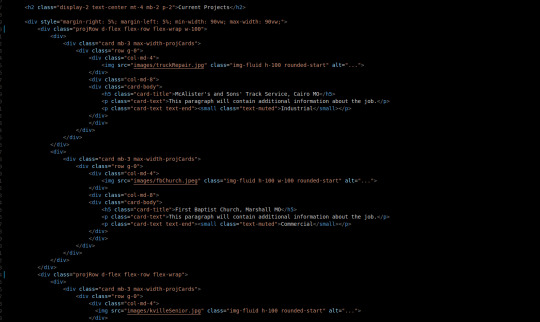
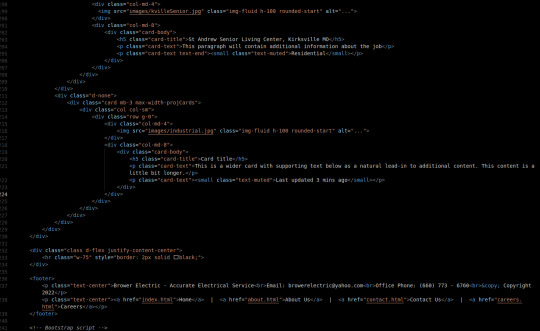
Our Current projects will be contained in a div that is always 90vw wide with 5% margins on either side.
Originally, I wanted to keep everything in a Bootstrap Grid, but they occupy the space between CSS Tables/Grids and Flexboxes. For this particular situation, Flexboxes will be the best utility because the justify-content-between tool sounds like it will be useful for the way I want the responsiveness to work.
There are currently 2 projRow divs with 2 unstyled "col" divs in each that contain one bootstrap card.
The rows are flexed with flex wrap enabled and they take up 100% the width of their parent section.
The cards are the basic Bootstrap 5 card components. They use a grid and have several pre-made breakpoints in the cards and pre-styled classes for card content.
The max-width-projCards helps me control the width of the cards.
We have a div that centers its content. It contains an <hr> (horizontal line) tag that is 75% the width of the page and has a 2px black border.
Then we have our footer. 2 centered <p> tags one has the footer paragraph with <br> tags separating the lines. One is a simple footer nav.
The CSS:

I did not write much custom CSS here. I changed the card-text to black since my default <p> color is white. The title also got some styling to match the page.
The .max-width-projCards sets the max width to 100% of the viewport. But by default it is 500px.
The projRow contains that space around justify content thing I was talking about earlier. It keeps all the divs organized equally apart.
Conclusion:
This commit, I learned more about the peculiarities of the Bootstrap Grid and a situation where a more traditional flex-box is appropriate. I think it is important that I learn more about these core code-design decisions as I improve in my skills as a developer.
You can visit the site's github repository here: https://github.com/Xacheri/BrowerElectric
6 notes
·
View notes